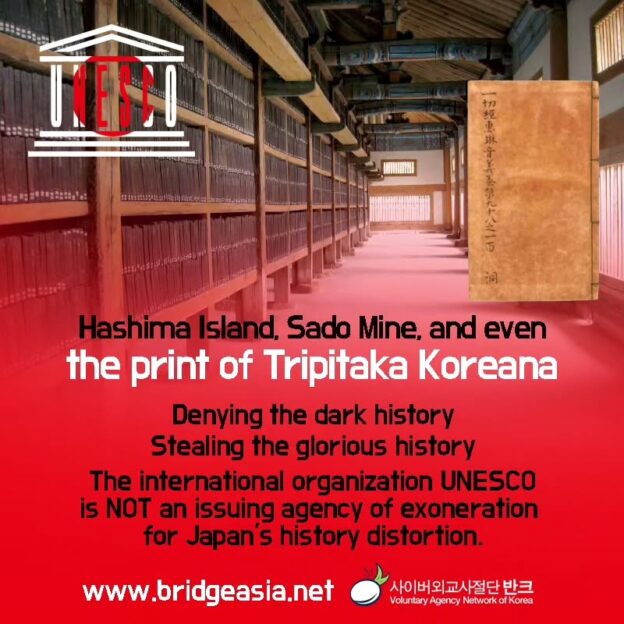
The Japanese government recently announced its intention to nominate a collection of three Buddhist scriptures housed at Zojoji Temple in Tokyo for inclusion in UNESCO’s Memory of the World Register. However, controversy has arisen over the fact that the collection includes printed editions of the Tripitaka Koreana, a Korean National Treasure and an item already inscribed in the UNESCO documentary heritage list.
The Tripitaka Koreana, preserved at Haeinsa Temple in Hapcheon, South Korea, is a crucial historical and cultural artifact that reflects not only Buddhist heritage but also the national consciousness of the Goryeo Dynasty, which resisted foreign invasions. While several nations historically produced woodblock-printed Buddhist canons, the Tripitaka Koreana at Haeinsa remains the only surviving complete original woodblock collection. Printed copies of these texts were later disseminated to various countries, including Japan.
Japan’s Ministry of Education, Culture, Sports, Science, and Technology has stated that it plans to apply for UNESCO registration of the Buddhist texts at Zojoji Temple, which include prints of the Tripitaka Koreana obtained from Korea. The ministry argues that these texts are among the few surviving complete Buddhist canons predating the 15th century.
This nomination raises concerns about historical distortion. The original woodblocks of the Tripitaka Koreana remain intact at Haeinsa Temple and have already been inscribed on UNESCO’s Memory of the World Register under South Korea’s initiative. Furthermore, the printed copies housed at Zojoji Temple were produced at a later date, not directly from the initial creation of the Tripitaka Koreana.
UNESCO’s Memory of the World program prioritizes the authenticity and irreplaceable nature of documentary heritage. Since the Tripitaka Koreana already holds UNESCO status, Japan’s attempt to register printed copies of it appears unnecessary and misleading.
Another point of contention is Japan’s use of an ambiguous designation—“Three Buddhist Scriptures at Zojoji Temple”—for its nomination. This vague title obscures the direct link to the Tripitaka Koreana, making it difficult for the international community to recognize the texts’ Korean origins. If approved, this could lead to widespread misperception that these texts are part of Japan’s cultural heritage, further fueling historical inaccuracies.
This is not the first time Japan has faced criticism for misrepresenting history through UNESCO nominations. Two years ago, Japan submitted the same Zojoji Temple texts for consideration, but the application was ultimately rejected in May 2023. Nevertheless, Japan is once again pursuing their inclusion, raising concerns that the move is part of a broader effort to distort historical narratives.
Japan has previously used UNESCO recognition to present a revisionist version of its history. A prominent example is the controversial UNESCO inscription of Hashima Island (commonly known as Battleship Island) and the ongoing bid for the Sado Mines to be designated as a World Heritage Site.
During Japan’s colonial rule, thousands of Koreans were forcibly taken to work under brutal conditions at these sites. Forced laborers endured extreme exploitation, harsh working environments, and inhumane treatment. However, the Japanese government has failed to offer a genuine apology or acknowledge the full extent of these abuses. Instead, it has promoted these locations solely as symbols of Japan’s industrialization, whitewashing their darker histories.
Given this precedent, Japan’s renewed push to register printed copies of the Tripitaka Koreana in UNESCO’s documentary heritage list raises serious concerns. The international community and South Korea must remain vigilant to prevent historical misrepresentation.
In response, the Voluntary Agency Network of Korea (VANK) has launched a campaign to expose Japan’s attempt to claim Korea’s Tripitaka Koreana as its own. This follows VANK’s previous efforts to counter Japan’s historical distortions regarding Hashima Island and the Sado Mines.
As part of this initiative, VANK will produce and distribute posters in Korean and English through social media platforms, informing the global community about Japan’s misleading UNESCO nomination. Additionally, VANK plans to launch international petitions and policy appeals to raise awareness and prevent further historical inaccuracies.
By taking proactive measures, South Korea aims to safeguard the integrity of its cultural heritage and ensure that the true history of the Tripitaka Koreana is accurately conveyed to the world.